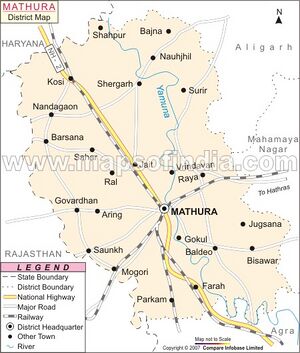Chhargaon
| Author:Laxman Burdak, IFS (R) |

Chhargaon (छड़गाँव) is a historical village in tahsil and district Mathura in Uttar Pradesh, India
Variants
- Chhadgaon (छड़गाँव) (जिला मथुरा, उ.प्र.) (AS, p.348)
- Chhargaon (छड़गाँव)
- Chharhgaon (छढगाँव)
Location
Chharhgaon is a Village in Farah Block in Mathura District of Uttar Pradesh State, India. It belongs to Agra Division . It is located 16 KM towards South from District head quarters Mathura. 10 KM from Farah. 385 KM from State capital Lucknow. Chharhgaon Pin code is 281005. Nearby villages: Khediya ( 1 km ), Dhana Teja (2 km ), Bhainsa (2 km ), Sersa (3 km ), Samaspur (3 km ) are the nearby Villages to Chharhgaon. Chharhgaon is surrounded by Mathura Block towards North, Baldeo Block towards East, Govardhan Block towards west, Achhnera Block towards South. This Place is in the border of the Mathura District and Agra District. Agra District Achhnera is South towards this place . Also it is in the Border of other district Kanshiram Nagar .
History
A statue of Naga was obtained from Chhargaon of the period of Kushan ruler Huvishka founded by Senahasti in 118 AD.[1] It was set up at a water-tank in the fortieth year of Kushana era during the reign of king Huvishka.
Chhargaon Statue of Naga
Dr Naval Viyogi[2] writes that ....Among the numerous Naga images recovered in the Mathura district the most
[p.245]: valuable specimen is undoubtedly the inscribed statue from Chhargaon a village situated 5 miles almost the south of the city of Mathura. It is now preserved in the local Museum (Mathura Museum Catalogue P-60 No C. 13). The spirited attitude of this image deserves special notice. The Naga is shown standing with his right arm raised over his head as if ready to striKe. The left hand is broken, but probably held a cup in front of the shoulder the head is surmounted by a seven headed snake-hood. From well preserved inscription incised on the back of the image it appears that it was set up at a water-tank in the fortieth year of Kushana era during the reign of king Huvishka.
The Chhargaon statue represents the best and possibly one of the earliest specimens or a distinct class of Naga image, of which numerous examples have come to light in the Mathura district. These icons still receive the worship of the rural population, but under a different name.
They are invariably designated as "Dau-ji" (meaning, the elder brother) or Baldeva the image of Balrama found at Tumain in Gwalior state and reproduced ASR (1918-19) Part i P-22 Pl XIII). Modern images of Baldeva, which are manufactured in such large numbers at Mathura and Brindaban, are nothing but imitations of the ancient Naga figures.
How the images of the Nagas came to be confounded by the villagers with effigies of Baldeva (Balrama), the elder brother of Krishna, it is not difficult to explain. Baldeva is believed to be a reincarnation of Sesha and we shall see that in Sanskrit literature too, he is sometimes completely identified With his spiritual father, the world serpent."
- इस स्थान से एक विशाल नाग प्रतिमा प्राप्त हुई थी जो अब मथुरा संग्रहालय में है। यह लगभग आठ फुट ऊंची है।
- इस पर अंकित एक अभिलेख से सूचित होता है कि महाराजाधिराज हुविष्क के समय में *कनिष्क संवत् के चालीसवें वर्ष (118 ई.) में सेनहस्ती तथा उसके मित्र ने इस मूर्ति की प्रतिष्ठापना की थी।
- इस मूर्ति में नाग की कुंडलियां बड़े वास्तविक रूप में प्रदर्शित हैं। अभिलेख से विदित होता है कि ई. सन् के प्रारंभिक काल में नागपूजा देश के इस भाग में विशेष रूप से प्रचलित थी।
छड़गाँव
विजयेन्द्र कुमार माथुर[3] ने लेख किया है ... छड़गाँव (AS, p.348): इस स्थान से एक विशाल नाग प्रतिमा प्राप्त हुई थी जो अब मथुरा संग्रहालय में है। यह लगभग आठ फुट ऊंची है। इस पर अंकित एक अभिलेख से सूचित होता है कि महाराजाधिराज हुविष्क के समय में कनिष्क संवत् के चालीसवें वर्ष (118 ई.) में सेनहस्ती तथा उसके मित्र ने इस मूर्ति की प्रतिष्ठापना की थी। इस मूर्ति में नाग की कुंडलियां बड़े वास्तविक रूप में प्रदर्शित हैं। अभिलेख से विदित होता है कि ई. सन् के प्रारंभिक काल में नागपूजा देश के इस भाग में विशेष रूप से प्रचलित थी।

